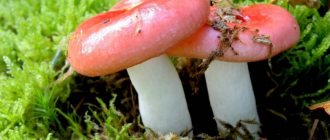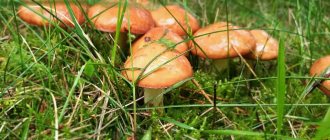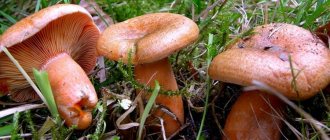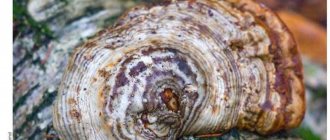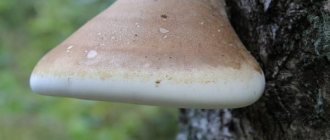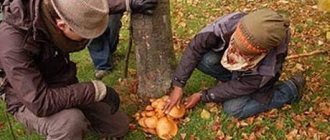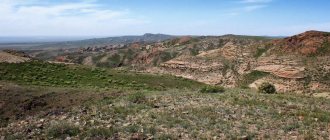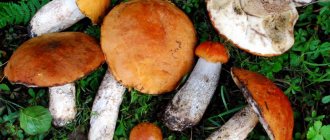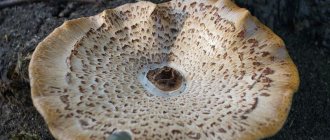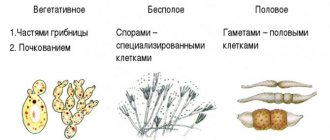Oak polypore is one of the most famous mushrooms that grows on oak bark. In Latin, phellinus igniarius is translated as a smoking plug. In its shape and method of fastening it is very similar to a cork in a tree.
Once upon a time, oak tinder was used for smoking.
In nature, it has a counterpart - the false oak tinder fungus. It is most often found in the forests of Ukraine and Belarus. It is common on oak bark, but is sometimes found on deciduous trees, such as birch or willow.
The oak mushroom is yellowish-brown in color and has white spots near the core. The fabric is dark brown, fibrous. Where it is attached to the tree bark it is yellow in color.
If we talk about the false representative, then it has a brown-rusty color and a tubular rusty layer. The top may have a grayish-brown or brownish-red tint. The shape is kidney-shaped.
At the same time, the pulp of both types is quite fragile. In appearance, it consists of many small tubes, which makes both types even more similar.
Disease Control
The oak polypore is an inedible mushroom, but when considered as a research subject, it has incredible properties. Therefore, at the beginning of the twentieth century, scientists created a research group that began studying this species.
It has been proven that the mushroom promotes the regeneration of cells that cause tumors (or cancer). People who suffer from cancerous tumors use it on their own in various settlements in India and Africa and live much longer.
Scientists from all over the world began to join the research and its detailed study, which helps to find a complete and accessible cure for cancer.
After some time, scientists discovered that this mushroom can be used in the treatment of diabetes and as a remedy that prevents the formation of blood clots. At the same time, anti-inflammatory properties have also been identified.
There are references to its use in folk medicine.
Interesting Facts
Fomitiporia robusta.
- At one time, a smoking mixture was made from the pulp of this mushroom.
- This mushroom is a promising raw material for the pharmaceutical industry. Its properties have not yet been fully studied, but its beneficial effects on cancer have already been proven.
False representative
False oak polypore does not have medicinal properties, it just has a destructive effect and is a pest of deciduous forests.
The double can affect any tree that is older than 20-25 years (sometimes from 30-35 years). If it appears on the bark of a tree, it means that the tree urgently needs treatment. If the false tinder fungus gets into food for a person or animal, it will cause instant poisoning of the body. Sometimes such poisoning can lead to death.
The tree on which this mushroom appeared will no longer produce first-grade wood. At best, if it is not completely affected, then you can get second-grade wood. In other cases, firewood is made from the affected tree.
Fungi are called arboreal because of their main feature - they penetrate the bark of a dead or living tree and decompose it using special enzymes. By destroying cellulose and other polysaccharides, they use them for their own development and growth. They belong to the group of xylotrophs.
There are edible and inedible types of these mushrooms, studied by the science of mycology. Edible parts are useful for humans, contain proteins, vitamins B and C, iron, phosphorus and calcium. “Muer” is the name of a tree mushroom translated from Chinese, which has long been often used in Pan-Asian cuisine.
How to grow oyster mushrooms on stumps (video)
However, it is necessary to take into account the specifics of eating such fruiting bodies. For example, the conditionally edible sulfur-yellow tinder fungus, which grows on deciduous trees, can be used for food purposes only at a young age. Older, overgrown specimens may have hallucinatory effects or cause quite severe food poisoning. It is also important to note that the most toxic are the fruiting bodies of fungi growing on coniferous wood and old, already decaying specimens.
Features of wood mushrooms
Many types of tree mushrooms act as forest health workers, since they are bred on weakened trees and help the natural selection of quality species. Representatives of such “orderlies” known to us, for example, are honey mushrooms, which grow beautifully on stumps in a large family and attract mushroom hunters with a spicy aroma. In addition, they are tasty, crispy, and are especially loved by gourmets when marinated.
But there are mushrooms that are completely different from traditional ones; they have neither a cap nor a stem. They are qualified and recognized by their shape and appearance, which reminds us of things familiar in everyday life. It never occurred to anyone to collect them and taste them, so the taste qualities of these eccentric specimens are not known for certain.
Such xylotrophs can be distinguished by a description of their appearance:
- Meat pieces (Askokorine meat);
- Resin in the form of a drop (Exidia ferruginosa);
- Bubble foam (Dacrimitses vanidas);
- Corals, sponge (Kalocera).
Even among mushrooms there are parasites that eat their relatives. For example, the sulfur-yellow hypocrea, which feeds on colonies of exidia or tremors.
Particularly dangerous parasites for forests include northern Climacodon, a representative of the subspecies Polypores. It penetrates into the body of a healthy tree through cracks and cuts and completely destroys it within 4 years.
Gardeners and park workers should be wary of such parasites, because they can completely destroy the garden.
Types of tree mushrooms
Mushroom hunters pay attention to apparently unusual species found in the forest on the trunks of rotten or diseased trees and dead wood. In mid-summer and autumn, you can find adult specimens of the most interesting mushrooms, a description of which is presented below.
Askokorine meat
It got its name because the fruiting body resembles pieces of meat of pink-violet shades with plates no more than a centimeter, united over one saucer. Most often found on birch stumps. Does not have a pronounced aroma. The unsightly appearance scares off mushroom gourmets, so its taste is unknown.
Bjerkandera
Belongs to the tinder family and is distinguished by tape-like growth within one year. A mature mushroom of dark brown color resembles a braid of caps, no larger than 3 cm in size. The pulp is fragile, gray in color, and odorless. A thin spore-bearing layer with a clear boundary separates the body of the mushroom from the brown oily cap, as if always wet and grayish at the ends.
Read also: How to plant aquarium plants correctly
Spreads on dead wood and dead wood. It tastes like regular tinder fungus.
Oyster mushroom
Oyster mushrooms quickly burst into our lives, greatly facilitating the preparation of many dishes with rare species of tree mushrooms. Growing quickly in an artificial environment, having a wonderful aroma and good taste, they have become undoubted sales leaders. Specimens bred on mushroom farms are not comparable in taste to wild varieties. They grow in large families on the trunks of living and dead deciduous fruit trees.
You need to look for them in spring and autumn in Crimea.
The fruiting body consists of a long elastic stem and a matte cap. Oyster mushrooms come in a variety of colors, from pale gray to orange, and all of them are edible and tasty.
Hypocrea
Hypoclea sulfur-yellow is an inedible parasitic mushroom that feeds on relatives of the Trembling family (most often they include Exidia glandularis). Accordingly, the seasons and places of growth of this species coincide with its “victims”.
Appearing on the body of the trembler, the hypocreas grows several yellow spots, which then merge into one surface. It forms a large golden spot on the body of the tree fungus with black dots - spore-forming fruiting bodies. It looks like a dense, uneven sponge ranging in size from 1 to 15 cm.
Ram mushroom
This fast-growing mushroom from the polypore family is also called Grifola curly. In our country it is rarely found, only in deciduous forests on old logs and stumps. Such mushrooms weighing 9-10 kg have been found in nature.
Many thin legs of the ram mushroom turn into brown caps with gray and greenish hues along the wavy edges. The light fruit body has beneficial properties and smells pleasantly of nuts.
For these properties, the mushroom is widely used in cooking and has become the medicinal basis of folk recipes for the treatment of pulmonary diseases.
Dacrimitses
A fairly rare small, up to 0.5 cm, yellow oval mushroom. It loves water, dampness and rotting stumps of coniferous trees, so in dry weather it hides in the bark of dead wood, as if spreading out and becoming flat.
Due to its yellow hue and structure, it looks like foam bubbles scattered in small drops on wood. The body of Dacrimyces has neither taste nor aroma. It is inedible, but not poisonous either.
Kalocera adhesive
In the forest, it usually settles on rotten wood and occupies this place completely, that is, other mushrooms will no longer grow here.
Kalocera strongly resembles coral, bright yellow, sometimes orange. Reaching a length of 6 cm, the horn-like processes grow together at the base and “create” a bouquet. Such formations parasitize on rotten wood and reproduce throughout the summer.
Each mushroom, rubbery to the touch, has 2-3 sharp, branched tops.
This species was classified as neither edible nor poisonous due to its rarity.
Chinese muer mushroom
The name of this delicious mushroom lies in its main place of growth - China, but sometimes it can be found in the eastern forests of Russia. It grows mainly on the trunks of living trees, preferably alder.
Brown, almost black, with a thin body, similar to an ear. Due to its delicate jelly, slightly crunchy structure and sweetish and smoky taste, muer is widely used in the cooking of China, Japan, Vietnam and Thailand.
Climacodon Northern
You can call him a real forest orderly. In mid-summer, it settles on old and diseased deciduous trees and destroys them in a couple of years. It belongs to the tinder family and looks like a very typical representative of these fungi.
The light yellow porous body and slightly brown caps of Climacodon with a radius of up to 15 cm form a multi-tiered attractive structure. In places where the spores form, they have soft spines - a rather rare occurrence for such breeds.
Its taste and smell are unpleasant, so this specimen has no experience of use in cooking or pharmaceuticals.
Honey fungus
The edible tree mushroom, familiar in appearance, taste and color to every person, is original in that it can be grown in an ordinary city apartment. And how, read on our website!) But the taste value of the found natural specimens growing on stumps and old deciduous trees is much higher.
They are found in all forests of Russia, growing in large families - up to 50 pale gray legs and gray-brown caps with one base.
tinder
There are many varieties of tinder fungi - this is one of the most popular objects of study in mycology. Its habitats are deciduous forests and parks, especially with elms.
Yellow caps with a diameter of 15 cm and brown legs 10 cm long are covered with brown scales. Those who like to cook these mushrooms need to collect only young specimens with dense, moist pulp, and up to three harvests can be taken over the summer and autumn.
An inedible mushroom, the medicinal properties of which elevate it to the category of the best medicinal xylotrophs of its kind. Dark brown or light gray lamellar semicircular growths on birch trunks have a dense, brittle structure and a putrid odor.
Biologically active substances and fiber in the fruiting body of chaga provide folk medicine with a substrate for the preparation of medicinal decoctions and infusions, teas and powders. As long as there are birch groves in Russia, we will be able to use the unique beneficial properties of the mushroom for the benefit of human health.
Golden scale (royal honey fungus)
Most often it can be found on the trunks of weakened and dead poplars, birches, and alders. Yellow-golden caps up to 20 cm in diameter on a thin long stem are covered with brown scales.
Young specimens appearing in mid-summer are often confused with honey mushrooms. But this mushroom is significantly inferior in taste to its well-known relatives, so it is not consumed as an independent dish.
It has an inedible, but also non-poisonous close relative - the poplar scale (pictured below).
Shiitake
Japanese forest mushroom, imperial mushroom or lentinula edible - these are the names found in this famous tree representative studied by mycology.
Features:
- fibrous stalk;
- brown round cap with lightened plates;
- scales on dry skin.
It grows most often on oak. The tasty pulp, giving off a peppery taste, as well as the medicinal properties of the species have become widespread in cooking and medicine.
Read also: Japanese rooster with a long tail
Exidia ferruginosa
The xylotroph from the Tremor family is difficult to describe externally, since it often changes its shape depending on climatic conditions. It resembles black resin drops and with its large family envelops the entire trunk of young branches growing on the remains of wood. The pulp of the fruiting body is jelly-like, has no taste or aroma, so it is of no value in the kitchen.
Inedible varieties of mushrooms in birch groves
In addition to edible species, poisonous varieties of mushrooms are also frequent residents of birch groves.
Russula brittle
Russula brittle is a bright representative of the Russula family, which is often found in the forest. Domestic experts classify the mushroom as a conditionally edible type; in Western literature, Russula is classified as an inedible representative of the forest. This is due to the fact that the pulp has a pungent odor and taste.
You can’t help but pay attention to the cap of this species, as it has a bright purple color. It also has a convex shape. On the back of the cap there are sparsely spaced plates that grow to the top of the stem. The leg itself is long, white, and has a brittle consistency. The lower part of the leg is expanded. This variety is found from late summer until the end of October.
Thin pig
A striking representative of the pigweed family, which occurs from June to mid-autumn. The mushroom has a small cap that grows up to 12 cm in diameter. It is funnel-shaped, with a hole in the center and edges curved inward. The color of the cap is olive with a brown tint. In young fruits, the surface of the cap is rough, while in mature fruits it is smooth.
Thin pig
The pulp is soft and dense, pale yellow with a brown tint. After cutting, the flesh immediately darkens. The leg is long, on average 10 cm in height, dirty yellow in color. After rain or during periods of high humidity, the surface of the mushroom becomes covered with a slippery film.
Death cap
The pale grebe is a well-known poisonous inhabitant of forests. Its distinctive features are the pale yellow color of the cap and the presence of an ovoid seal on the lower part of the stem. The young mushroom begins to germinate in the form of a beige chicken egg covered with a film. The mature fruit body has a convex cap with a smooth surface of green or light olive color. Over time it becomes grayish.
Death cap
The pulp is white, odorless and tasteless. The stem is about 15 cm high and has the same color as the cap, sometimes covered with a moire pattern. On the back of the cap there is a plate system. On the top of the stem there is a ring, fringed and wide, which disappears with age. This variety is often confused with russula or champignons. The peak production of toadstools occurs in mid-summer and lasts until mid-autumn.
Satanic mushroom
The satanic mushroom belongs to the Borovikov genus and the Boletaceae family. The fruiting body is large. The hat grows up to 25 cm in diameter, the shape is semi-circular, with edges curved inward. The color of the cap is mainly dirty white, with a grayish tint, and maybe greenish. The flesh of the cap is white with a yellow tint, immediately turns blue after cutting, and later turns red. The pulp of the leg has an unpleasant odor.
Satanic mushroom
The tubular system is dense, with yellow tubes with a green tint. When pressed they immediately turn blue. The leg is low and has the shape of a barrel. The upper part is colored red with a yellow tint, the middle part is orange, and the lower part is yellow with a brown tint. Also on the leg there is a mesh pattern in the form of large ovoid cells. The satanic mushroom grows from June to October.
The benefits and harms of tree mushrooms
The benefits of edible species of tree mushrooms are scientifically proven. They contain absolutely no fat. Their main useful components are:
- vegetable protein;
- vitamins C, B, especially a lot of B3;
- Microelements calcium, phosphorus, iron.
In such types of mushrooms as tinder fungus, shiitake, chaga, it is not culinary, but pharmaceutical properties that predominate. Various substances and mixtures are prepared from them that can treat the symptoms of certain diseases:
- lack of iron in the blood;
- high blood pressure;
- high levels of stomach acidity;
- reduced immunity.
Tree fungi can be considered harmful only because they spread widely and quickly on healthy trees in human-cultivated areas - gardens, parks, artificial forests. Once on the bark of a damaged area of a healthy trunk, fungal spores quickly multiply and destroy it in just a few years.
If wood damaged by animals or frostbitten is treated in time with garden varnish, this danger will disappear.
Where and when do they grow?
Fungal spores are carried by the wind, and when they get inside the tree through cracks and chips in the trunk, they begin to multiply. Thus, delicious shiitake and muer grow in Asian countries (China, Korea and Japan), in the Primorsky Territory and in the Far East. The usual honey mushrooms can be found everywhere, in any forest and even in a city park.
It’s not for nothing that autumn is the mushroom season, because it is during this period that mushroom pickers begin their hunt. This applies to both ordinary mushrooms and wood mushrooms, which are found already in March and continue to grow until frost.
Tree mushrooms can be found both in the forest and in gardens and parks
There are many varieties of edible or medicinal mushrooms, such as honey mushrooms and oyster mushrooms. Mycelium grows quickly, which makes growing them at home an affordable and profitable activity.
Mr. Summer Resident recommends: tree mushrooms - beneficial properties, use in cooking
The tree mushroom Chaga birch has become famous for its medicinal properties - teas and decoctions from it have a powerful immunostimulating and tonic effect.
Planting mushrooms on a farm has become a profitable business and now we often see tasty and nutritious oyster mushrooms on sale, which are also classified as woody mushrooms. In nature, they come in yellow, greenish and other shades and grow in a large family. Forest species are much more fragrant than their artificially bred relatives. A big plus is that they do not have poisonous counterparts.
Tree ears, as the mushrooms are called because of their resemblance to the shell of an ear, are very popular in oriental dishes. However, they are rarely prepared as an independent dish, since they do not have a special aroma or pronounced taste. Mushrooms are good as a side dish in combination with meat, giving it a subtle smoky flavor. The crispy and dense consistency is pleasant to the taste and nutritious, especially well seasoned.
Undoubtedly, tree mushrooms have taken their rightful place in human nutrition: it is not for nothing that we are increasingly seeing them on supermarket shelves, thereby enriching the diet with healthy and nutritious protein products.
Few mushroom pickers, when going into the forest, pay attention to mushrooms growing on trees, because many of them are inedible. But there are also worthy species that have a wonderful aroma and excellent taste.
Description of mushrooms growing on trees
Grifolka curly
The curly mushroom is also known as the ram mushroom. It is rarely found in nature, so few mushroom pickers know about its existence. Habitat: deciduous forests. At the same time, it grows on trunks with a wide leaf blade (maple, chestnut, oak, beech). These edible mushrooms appear on trees in late summer and early autumn. They weigh from 5 to 10 kg.
Appearance
Like all mushrooms on the tree, the curly mushroom has a multi-layered structure. The flesh is fleshy, light beige. The caps, of which the tree mushroom has many, are flat and covered with gray-white or beige dense skin. They are supported on a thin stalk, the diameter of which does not exceed 2 cm. The inner side of the ram mushroom is light. The edges of the caps are slightly wavy.
Beneficial features
This variety is valued for its bactericidal properties. Even in ancient times, medicinal powder made from this mushroom helped cure tuberculosis. Today, folk healers make tinctures, decoctions, ointments and extracts based on it.
The mushroom is a record holder for vitamin content. In addition to vitamins, it is rich in amino acids, minerals and trace elements, which allows it to be used even in traditional medicine.
Useful for people with high blood cholesterol levels or disorders of the nervous system. Recommended for use for diabetes and cancer.
Use in cooking
As for taste, the mushroom culture has a rich aroma and nutty notes. But, despite the good taste, it is rarely prepared. Only young specimens are used in cooking. Adults have much worse taste, and they can ruin any dish. Grifolka should not be consumed raw.
Oyster mushroom or Oyster mushroom
- Consists of a matte cap and an elastic, short stem.
- It is edible and very tasty, and also smells pleasant.
- It grows in deciduous forests on rowan and oak stumps, where it settles in dense multi-tiered structures.
- The color of the mushroom varies from orange to light gray.
- It is easily cultivated at home and is grown by a number of connoisseurs of its taste.
Chicken mushroom
The second name of the chicken mushroom is sulfur-yellow mulberry. Its peculiarity is that during heat treatment, not only a strong chicken smell appears, but also a characteristic taste. Many people who have given up eating meat include this product in their menu. And if a person is not warned what the dish is made of, then he will be sure that chicken is present in the composition. It is especially valued by Germans and Americans, who consider it a delicacy. Found everywhere. Grows on the trunks of any crops, including garden ones. Fruits throughout the summer.
The sulphur-yellow mulberry is a parasite. It, penetrating through damaged areas of the bark, destroys the tree on which it grows. An oak or maple entwined with this parasitic species dies within 6-10 years.
Appearance
Mushroom pickers who do not know about the existence of the sulfur-yellow mulberry are repulsed by its appearance. The cap and body of this type are colored yellow. In young mushrooms it is especially rich. Because of this, it is mistaken for poisonous. The body is represented by thin hyphae (threads) that are intertwined.
Weight varies from 6 to 10 kg. The wavy edges of the caps, covered with a thick peel, are slightly curved inward. The inside of the caps is painted beige-yellow and has a porous structure. The legs are narrowed towards the base and have a diameter of 1.5-2.5 cm.
Beneficial features
Chicken mushroom normalizes liver function
Contains antibiotics. This allows it to be used to treat staphylococcus. It is also rich in resinous substances that help fight respiratory diseases and normalize liver function. The use of this variety is also recommended for those who have problems with the biliary tract. Nutritionists use products that contain mushroom extract to lose excess weight.
Use in cooking
Refers to conditionally edible mushrooms. Only young mushrooms are suitable for consumption. Adult mushrooms growing on tree bark are poisonous. Mulberries, which are parasitic on poplars and willows, are also not used in cooking. This is explained by the presence in the bark of these crops of bitter substances that permeate the pulp of the parasite that has settled on them.
Read also: How to choose a gas generator for your dacha
Horn-shaped hanger mushroom
The hanger mushroom is the most popular type of edible mushroom that grows on trees. Today it is not only collected in the forests, but also grown on mushroom farms. It grows equally well on tree trunks and stumps. But only on those stumps that receive nutrients from the roots. If the root system is dead, then the hanger mushroom will not grow. They prefer oaks, elms and maples. They begin to bear fruit in late spring and finish in early autumn. You can see this mushroom on a tree throughout Russia and Ukraine.
Appearance
The shape of the cap resembles a funnel. Rarely does the cap have a flat shape. The skin is of medium thickness, beige, ocher or light brown. The color of the cap depends on age. Young mushrooms are colored beige, and old ones are light brown. In cross section they are white or light brown. They grow in small groups. Their weight is, on average, 400 g. Sometimes it reaches 600-800 g.
Beneficial features
Their benefit is that they normalize blood pressure and lower blood cholesterol levels, and have a beneficial effect on the condition of the skin, nails and hair. Thanks to their medicinal properties, they help prevent the occurrence of gastrointestinal diseases, stimulate brain function and strengthen the immune system. They are not contraindicated for allergy sufferers and are able to remove toxins from the body.
Use in cooking
Horn-shaped hangers are used for preparing stews, soups, frying and stewing. The dense pulp has a pronounced mushroom aroma. Due to the fact that the pulp contains a large amount of chitin, it is processed carefully and for a long time. The heat treatment time for young mushrooms is 20 minutes, and for old ones - 30-45 minutes.
Inedible but very useful xylotrophs
As already mentioned, most tree mushrooms have hard flesh, which is not at all enjoyable to eat, and in some cases it is simply impossible, it is so hard. At the same time, among them there are very valuable specimens from a medical point of view. Based on them, medicinal products are made that help fight many diseases, including such as oncology.
READ Main species and characteristics of mahogany
Some of the most useful woody inedible mushrooms are:
- Chaga larch birch. The fruiting body is hoof-shaped, rough, with cracks. The skin is off-white and darkens with age. Long-lived, parasitizes trees for up to 20 years, the weight of one mushroom reaches 3 kg. The chaga pulp is yellowish. The most nutrients are found in young mushrooms growing on living trees.
- Lacquered tinder fungus (aka reishi). Grows on stumps and diseased deciduous trees. It has a small but very dense stem attached to the side of a very beautiful egg-shaped cap. The surface of the varnished polypore is shiny and wavy. Along the cap there are rings of a darker shade than the main color. The color can be different: orange, red and even yellow-black. The tasteless and odorless pulp is spongy at first, but quickly becomes wooden.
To summarize, we can say that although tree fungi are parasites that destroy trees and cause great harm to gardeners, nevertheless, some of these specimens also have benefits, both in gastronomic terms and in medicine.
Mulberry scaly
This is another representative of the group of conditionally edible mushrooms. It is popularly called the hare, pied, or elm. And in ancient times it was called Agarik white. They appear on weak and diseased trees. A special feature of scaly mulberries is that they can grow singly, although most often they grow in small groups. These mushrooms grow on walnut trees, oaks, lindens and maples. In addition, it is a fungus that also attacks fruit crops. They prefer a warm climate, which is why they are more common in the southern regions. They grow well both in the forest and in the city. In parks they settle mainly on hazel trees. They bear fruit from late spring to late summer.
Appearance
They have a large fruiting body. The diameter of the stem varies from 15 to 40 cm. In young elms, the cap is shaped like a kidney. Over time it becomes flat. The cap is painted white and has scales, as evidenced by the name. They are colored light brown or brown. Closer to the center the scales are larger and darker. There are scales on the stalk as well. The lower part of the cap has a tubular structure. The pulp has a pleasant mushroom aroma
Beneficial features
The mushroom is used for medicinal purposes
Medicinal properties allow them to be used in pharmaceuticals. They are part of medications that are used for poisoning with various poisons. They are also included in ointments for nail fungus. In folk medicine, scaly mulberries are used to prepare remedies that help fight pathogenic fungi.
Use in cooking
Vyazovik is practically not used in cooking. Dishes should be prepared from young specimens, which have juicy flesh. As it ages, it becomes tough and loses its taste. Before cooking these mushrooms, they are soaked. The duration of heat treatment is 40-50 minutes.
Also edible are boletus mushrooms, which grow near birch groves, and honey mushrooms, growing under aspen trees. Even novice mushroom pickers are familiar with their description. It is impossible to see boletus or honey mushrooms growing on tree bark. They feed from the roots of the host plant.
Description
Birch tinder fungus, according to various sources, is an edible or inedible mushroom - the opinions of experts on this issue differ significantly. Its inedibility is supported by its bitter taste, which is less pronounced in young individuals. They are offered to be eaten.
The species is considered a prime example of a parasitic organism. The tinder fungus on the birch gradually destroys the tree. The mycelium affects only dry or rotten, i.e. diseased, and therefore weakened specimens, and performs a cleansing function in the forest.
Birch is the only tree on which this species parasitizes.
The birch tinder fungus looks like this:
- the stalk characteristic of cap-legged mushrooms is missing;
- fruiting bodies are annual;
- in young specimens the fruiting body is egg-shaped, in adults it is flat, hoof-shaped, reaching 25 cm in diameter and up to 5 cm in thickness;
- the surface color of the mushroom is white or cream, covered with a film; with age it becomes brown or brown, hard;
- hymenophore – tubular;
- The pulp is white, with a strong characteristic mushroom smell and sour taste.
The species is distributed throughout Russia. Often lives in places with high levels of humidity.
Irina Selyutina (Biologist):
Back in 1967, a book by the Czech scientist V. Ripacek, “Biology of Wood-Destructive Fungi,” was published in Moscow, in which he described the birch polypore species as parasitic, settling on weakened trees. According to currently known data, this species is classified as an active wood destroyer, causing intensively developing yellowish-brown or reddish-brown rot of a destructive type. As a result, the wood very quickly becomes rotten.
The attitude towards the mushroom is ambiguous. Mycologists refer to its inedibility and parasitic nature, and people use its fruiting bodies as a means of traditional medicine. The pulp is not dangerous to humans, but is unsuitable for food due to its irreducible bitterness.
Differences between edible and poisonous
Poisonous mushrooms grow on trees more often than edible ones. Inedible mushrooms can be distinguished by several characteristics:
- Many inedible mushrooms have a large cap;
- the cap and flesh of inedible ones are often red or brown (in the dangerous southern ganodrema, for example, the flesh is dark red);
- In many varieties that are unsuitable for consumption, the stem is either absent or has a miniature size. And the caps look more like growths.
If it is unknown whether a variety is edible or inedible, you should not pick it up with your hands.
Some varieties cause enormous damage to forestry. A striking representative is the spruce mulberry. It parasitizes the body of coniferous crops. Its cap is dark purple (resembling the color of a blackberry), and the inside is orange or brown.
Useful tips
Tip #1
You can distinguish inedible tree mushrooms from edible ones by the following criteria:
- the former often have large, irregularly shaped caps;
- they have a leg completely or partially missing;
- inedible tree mushrooms have colored flesh.
If there are problems identifying such a plant, it is better not to eat it.
Tip #2
If a tree fungus appears in the garden, then get rid of it as soon as possible, as it can infect all the crops on the site. It’s better to prevent infection: feed, water, care on time, remove dried bark that is flaking or flaking. You also need to treat areas of cuts, cracks and other damage with copper sulfate (3%) or garden pitch.
Tip #3
Eat young woody mushrooms; they are juicier and have a distinct taste and aroma. Overgrown specimens become denser, dryer, tasteless, and some of them can cause food poisoning.
The effect of fungi on trees
All fungi growing on trees are parasites and have a negative effect on the condition of the tree. As a result of such relationships, trees die. If plants in the garden are affected, they must be disposed of immediately. Some gardeners believe that it is enough to cut out the affected branch and get rid of dry branches that have already died. But fungal spores quickly spread and end up under the bark of trees. They can also migrate from one plant to another. Spores ripen in most varieties by early autumn. The affected and dead branches must be destroyed before this time. Otherwise, the spores, once on the bark, form a mycelium from which mushrooms will grow. But not necessarily in the same year. The mycelium sometimes develops inside the trunk for 2-4 years.
The interaction between the affected tree and healthy plants should be minimized. Cut branches are burned. If you want to grow edible mulberries or boletuses, then it is better to grow them on stumps.
The exception is varieties growing nearby tree crops. During their growth, the root system of the tree is entwined with hyphae. It doesn't harm him. It shares carbon nutrition with the fungi, and in return receives water and minerals, which are well absorbed from the soil by hyphae. Plant remains are also a good source of nutrition for them. Such relationships are mutually beneficial.
Growing on the trunk
A group of organisms numbering several dozen species parasitizes living and dead wood. It received the common name “woody”. It includes both edible, high nutritional value, and poisonous specimens.
The spores of the parasite are carried by the wind, falling on the bark, they are embedded in microcracks and begin to grow inside the wood. By secreting special enzymes, the mycelium breaks down cellulose and sugars, feeding on them. The fruiting body begins to develop on the surface of the trunk, forming growths of various shapes.
A healthy plant is rarely affected by the parasite. Its victims are old, sick, damaged specimens.
A living culture affected by spores gradually collapses and dies. Having discovered signs of infection on dacha plantings, it is necessary to urgently take measures to clean the bark and disinfect the wood. An unhealthy trunk can cause the death of the entire garden.
